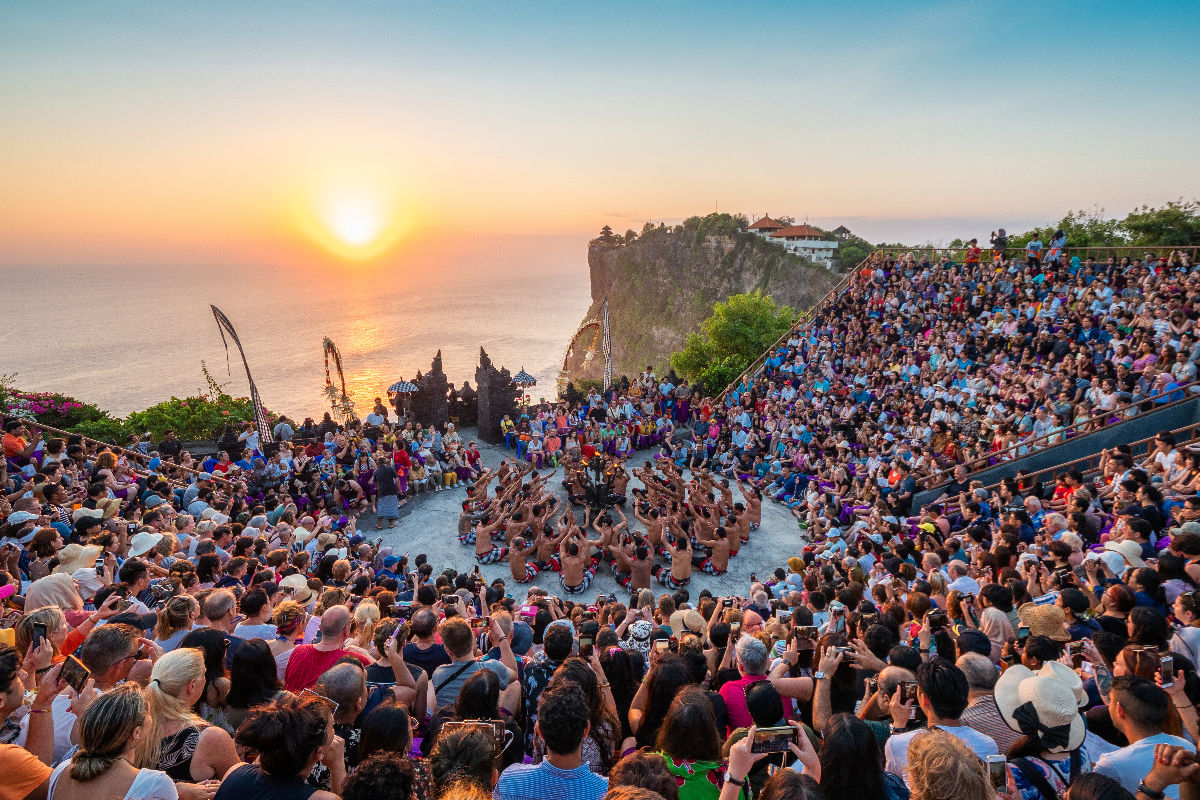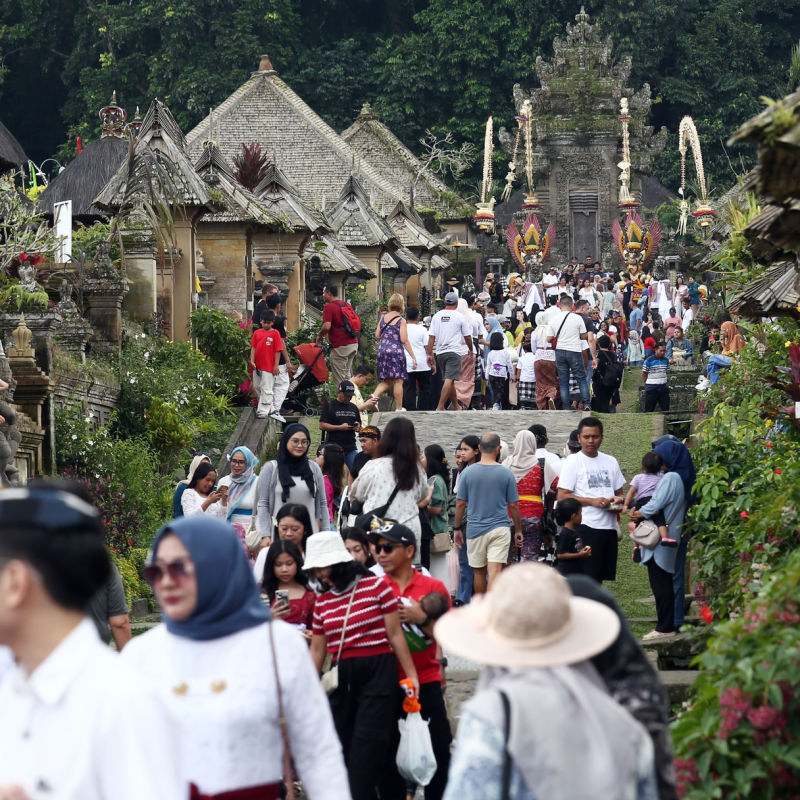Leaders in Bali have confirmed that the province welcomed over 6.3 million international tourists in 2024.
This confirms that 2024 was a record-breaking year for both Bali as a province and Indonesia nationally in terms of tourism. Nationwide, Indonesia welcomed over 12 million international tourists.

The Head of the Bali Provincial Tourism Office, Tjok Bagus Pemayun, told reporters that between 1st January 2024 and 29th December 2024, Bali recorded 6.3 million international arrivals.
While official figures for the 30th and 31st of December were not included in the final figures, it is clear that Bali smashed its tourism targets for 2024, where conservative forecasts projected 5.5 million international arrivals, up to 6 million.
Pemayun has confirmed that tourism targets for Bali in 2025 are 6.5 million foreign visits to the province. He told reporters, “The most important thing is not only that, what we expect is foreign tourists with longer stays, more spending money, and respect for local culture and society.”
The key focus for the Bali tourism sector is to promote both culturally respectful and sustainable tourism and encourage tourists to stay longer and spend more.
This is already happening, slowly and steadily the average length of stay in Bali by foreign tourists is increasing.
Data from November 2024 shows that the average length of stay for foreign guests a starred hotel in was 3.01 nights, up from 2.99 nights in October 2024.
The Room Occupancy Rate (TPK) of starred hotels was 59.69% in November 2024, slightly down compared to October, at 64.37%, but still higher than November 2023.
At first glance, an average stay of just 3 nights may feel rather small, especially since many long-haul tourists stay in Bali for vacations of 7-14 days.
However, many of Bali’s most frequent arrivals, including those from Malaysia and Singapore, tend to visit Bali for a long weekend.
The Acting Head of the Bali Central Statistics Agency, Kadek Agus Wirawan, explained to reporters how the different demographics of tourists had impacted travel trends over the last 12 months in Bali.
Wirawan explained, “Australia remains Bali’s main tourism market, while the Chinese market has recovered significantly after being affected by the COVID-19 pandemic.”
In November 2024 alone, foreign tourist visits to Bali reached 72,900 people, with Australian tourists contributing to 24% of all international arrivals, specifically 118,182 visits. India followed with 9.76%, 46,150 visits, and China 5.75%, or 27,183 visits.

In 2025, Wirawan explained that Bali must continue to diversify the kinds of traveler demographics and tourist nationalities that the destination is promoted to.
He noted, “In addition to maintaining the Australian market and optimizing China’s potential, the government and tourism players need to strengthen promotions in other countries such as South Korea and India.
Domestic travel has also played a huge role for Bali in 2025. While Bali is a top destination for domestic travelers in Indonesia, Java remains the most in-demand island for local tourists.

In 2024, Java Island was the main destination for domestic tourist travel and welcomed 69.87% of all domestic tourists in November 2024, which amounted to 56.32 million trips.
East Java was the province with the most trips, welcoming 16.33 million Indonesian tourists, followed by West Java, 13.66 million visitors, and Central Java, 11.17 million trips.
In 2025, we can expect to see even more promotion of West Bali and East Java as a combined tourism destination. These two untapped tourism destinations have so much to offer travelers of every demographic.

In late 2024, the Ministry of Tourism launched a new travel itinerary that takes tourists on what is now known as the 3B Tour, visiting North Bali, West Bali, and Bangyuwangi in East Java.
The tour visits Lovina Beach in North Bali, famously home to a resident pod of wild dolphins, before traveling on to Pemuteran and West Bali National Park and onwards to Bangyuwangi, which is the gateway from Bali to the iconic blue fires of Mount Ijen in Java.
Remove All Ads & Unlock All Articles… Sign up for The Bali Sun Premium

Plan Your Bali Holiday:
Book The Best English Speaking Drivers For Airport Transfers & Tours
Choose From Thousands of Bali Hotels, Resorts, and Hostels with Free Cancellation On Most Properties
Book Cheap Flights To Bali
Don’t Forget Travel Insurance That Covers Medical Expenses In Bali
For the latest Bali News & Debate Join our Facebook Community
SUBSCRIBE TO NEW POSTS
Enter your email address to subscribe to The Bali Sun’s latest breaking news, straight to your inbox.
Discover more from The Bali Sun
Subscribe to get the latest posts sent to your email.

Hns
Monday 13th of January 2025
And where can tou pay the tourist tax? The desk at the airport is gone
Jordan
Monday 6th of January 2025
I live here and my day to day life requires very little travelling. Zero in a car anyway as if I go somewhere I ride or take a grab scooter. I also have no interaction with the aggressive sellers, massage parlours, drug sellers, beach beggers in the seminyak-kuta strip that many tourists stay in.
If I was a tourist and saw all that plus spent hours stuck in cars in traffic I wouldn't be going home and recommending bali. I don't know how tourism keeps increasing.
Sven
Wednesday 8th of January 2025
@Jordan, tourism industry has a delay built into it.
People go to some place in the world based on the knowledge that others have shared after their travel to it. For example, in Europe, the delay is more or less 1 year. When you visit a place, you will either recommend (or not recommend) it to your friends. Those friends won't go the next day, but when their vacation time comes, usually the next summer/winter season. And their experience will be shared with their friends, who might go the next year.
Tourists go to Bali based on the positive feedback from 5 or 10 years ago, from the time when previous visitors called it a great place. Since these people couldn't go immediately, there is a delay. But a lot has changed in the past years in Bali, to the worse. So all these people go there with the paradise image in their heads (created many years ago). While reality is something completely different now. Horrendous pollution, corruption, lawlessness, neglect, etc.
If you want to know the trend for the future of Bali, look at the feedback of the people who come back from it these days. Even hard-core Australian tourists who been to Bali 10-30 times are saying that it was their last time, as it is simply not worth it anymore.
Paul
Monday 6th of January 2025
They need all the tourist that came to clean up the beach so it's clean for ceremony then the locals will just leave the crap on the beach for the tourist to clean up again
Randy
Monday 6th of January 2025
The title in this article is actually not pleasing to many of the locals in Bali for sure!!
indopama
Saturday 4th of January 2025
2024: 6.5 million with length of stay of 2.3 nights
20 years ago: 1.5 million with length of stay of 9 nights
more or less the same business....
Sven
Wednesday 8th of January 2025
@Exp, shorter stays because people quickly realize how low quality island they arrived to. Then changing their plans to leave as soon as possible.
Each friend I have talked to over the past year who visited Bali first time have said they would not go again, as it was disgusting.
Reality is that the shorter time you stay in Bali the better. The experience only gets worse with each passing day being there.
Thailand is century ahead of quality and much much less annoying to visit than Bali.
Shorty
Wednesday 8th of January 2025
@Exp,
Maybe the increase in Indian, Chinese and other regional countries who tend to stay for a shorter vtime.
Exp
Monday 6th of January 2025
@indopama, Shorter stays probably because accommodation and transport it is starting to be expensive.